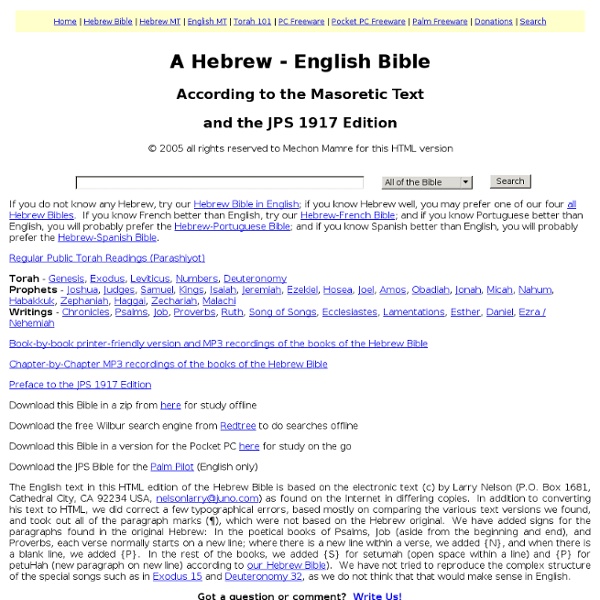The Visual Bible USA Buy Acts of the Apostles DVD movie $14.95
Acts of The Apostles DVD from GNN USA now only $14.95 Join with the physician Luke (Dean Jones), as he tells the enthralling story of danger, struggles and triumph that marks the birth of the Christian church. More > The Visual Bible lends itself beautifully to DVD technology. In addition to the superior format, you have multiple viewing options which include:
Hebrew Lexicon
The Old Testament Hebrew lexicon is Brown, Driver, Briggs, Gesenius Lexicon; this is keyed to the "Theological Word Book of the Old Testament." Also included are pronunciations of each word with alternate pronunciations if available. Bible Study Tools offers two Bible versions, King James and New American Standard, for studying within the Old Testament lexicons. NOTE: In order to see the actual Greek and Hebrew characters you must download and install the free BST Fonts.
Hebrew Alphabet
The Hebrew and Yiddish languages use a different alphabet than English. The picture below illustrates the Hebrew alphabet, in Hebrew alphabetical order. Note that Hebrew is written from right to left, rather than left to right as in English, so Alef is the first letter of the Hebrew alphabet and Tav is the last. The Hebrew alphabet is often called the "alefbet," because of its first two letters. Letters of the Alefbet Table 1: The Hebrew Alphabet
Hebrew Glossary
Then name Ashkenaz (Bereishit 10:3) has since the 10th century been identified with Germany. As the German and French Jews of the medieval period formed a uniform group in culture and religious customs, they were all referred to as Ashkenazim in contradistinction to the Sefardim or Spanish- Portuguese Jews. Ashkenazim are the people who use Nusach Ashkenaz, the prayer arrangement adopted by the medieval Franco-German Jews, including certain variations described as belonging to the Polish custom (Minhag Polin). In the 18th century, the Chasidic movement adopted the Sefardic arrangement of prayers; hence, the Chasidim have been called Sefardim on many occasions. The Ashkenazim in Eastern Europe developed an intense religious life, disseminating Talmudic scholarship among the people to a degree never before surpassed in Jewish history. A high Jewish literacy existed in an illiterate non-Jewish environment.
Study Tools
"Let them praise the name of the LORD: for his name alone is excellent; his glory [is] above the earth and heaven." Psa 148:13 In the Old Testament times, a name was not only identification, but an identity as well. Many times a special meaning was attached to the name. Names had, among other purposes, an explanatory purpose (e.g., Nabal, whose name means "fool," is the target of Abigail's explanation to David: "For as his name is, so is he; Nabal is his name, and folly is with him:" - 1Sa 25:25). Throughout Scripture God reveals Himself to us through His names.
Bibles
The Bible and the codex initially took shape within a Roman Empire that stretched from Syria to Scotland. Greek and Latin were the literary languages, and by fourth century Christianity was the state religion. In the early Middle Ages individual nations began to emerge, with their own languages, cultures, and religious traditions—orthodox Christian, heretical, and pagan—all influencing the ways in which Bible and book were perceived and produced. Still, the concept of "empire" continued to haunt ambitious leaders who saw faith as a way to unite their diverse subjects. Disseminating a religion of the Word involved both finding interpreters to preach in local languages and teaching people sufficient literacy for reading and copying texts. Missionaries often used a written version of the spoken language while different sounds required the creation of suitable scripts.
Bible Encyclopedia: Jonah
Hitchcock's Bible Names Dictionary Jonah or Jonas, a dove; he that oppresses; destroyer Smith's Bible Dictionary
Parallel Bible Study Tool
The Resurrection 1 A Luke 24:1-10: Matt 28:1-8; Mark 16:1-8; John 20:1-8But on the day of the , at , they to the the they had . 2 And they the from the , 3 but when they , they did not the of A Luke 7:13; Acts 1:21the . 4 they were , , A John 20:12 suddenly B Luke 2:9; Acts 12:7 them in ; 5 and as the women were and their to the , the men to them, “ do you the One the ? 6 He is not , but He A Mark 16:6has 1 Or been raised .
Who's Who in Bible Prophecy
The individuals listed below are Christians (past and present) who are passionate about their faith. Some are recognized pastors, scholars and teachers of Bible prophecy and eschatology (study of end-times) who also belong to various denominations. Also listed here are those from pseudo-Christian organizations (so-called Christian groups that adhere to doctrines outside mainstream Christianity).



